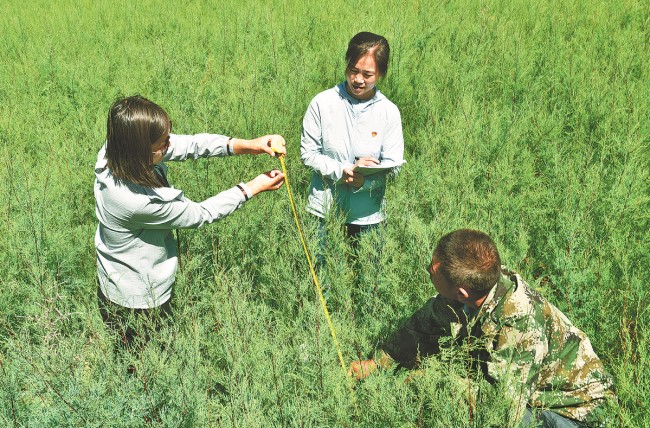Northwestern desert oasis holding back the sands

Jiang Liling (center) and her colleagues check the growth of shrubs they planted on the formerly sandy land. [Photo/China Daily]
At least twice a year, she and her colleagues spend about a month in the desert overseeing afforestation work on site. Every day, they cover about 20 kilometers on foot.
"We eat simply. At night, we have to be careful to keep our tents from being blown over," she said.
Sometimes, she remains at the test center in the desert waiting for a sandstorm to gather firsthand data on new materials and new technologies used in sand prevention and control.
Once, she and her colleagues were forced to walk for nearly five hours to get out of the desert because part of the way back had been covered by sand after a storm.
In 2007, Gansu's governance plan for the Shiyang River basin was officially approved and implemented. In Minqin, which is located downstream of the river, reforesting marginal farmland became an important task.
Jiang not only helped prepare the feasibility study report and implementation plan, but also worked to change the minds of people unwilling to give their farmland to the project.
Through patience and a willingness to help, she eventually gained their support.
In Xiqu town, which is located on the edge of the desert, some of the farmland was not included in the government project. Through her efforts, Jiang was able to ensure that 186.66 hectares of arable land in danger of desertification were properly treated, and the villagers received subsidies of 3.44 million yuan ($481,470).
She also taught villagers to graft cistanche salsa, or broomrape, a plant used in traditional Chinese medicine, onto saxaul trees. They set up a center on 306.66 hectares of land from which they harvest 100 metric tons of the plant a year, earning villagers some 2 million yuan.
Today, the environment in Minqin is better, and residents are much better off.
In Jiang's village, which is called Lianfeng, villagers are benefiting from growing greenhouse vegetables such as peppers, cucumbers and tomatoes.
"Minqin is an oasis that prevents the two deserts from becoming one. As an important barrier protecting the environment in northwestern China, it must have a better future," Jiang said.
Ma Aibin contributed to this story.
-
As AI encounters Dunhuang's art, the ancient caisson ceiling bridges centuries to the present.
View all stories

 Gansu thrives from green development
Gansu thrives from green development  >
>